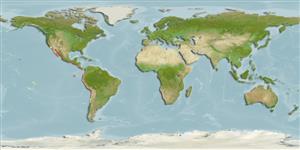Actinopterygii (ray-finned fishes) >
Perciformes (Perch-likes) >
Carangidae (Jacks and pompanos) > Caranginae
Etymology: Selene: Greek, selene = moon (Ref. 45335).
Environment / Climate / Range
Ecology
Marine; benthopelagic; depth range 0 - 50 m (Ref. 9283). Subtropical, preferred ?
Eastern Pacific: Redondo Beach in southern California, USA to Peru; rare north of Baja California, Mexico.
Size / Weight / Age
Maturity: Lm ? range ? - ? cm
Max length : 40.0 cm TL male/unsexed; (Ref. 55763); common length : 24.0 cm FL male/unsexed; (Ref. 9283)
Body very short, deep, and compressed; lower branch of first gill arch with 30 to 35 gill rakers; dorsal fin with 8 spines followed by another spine and 21 to 24 soft rays (VIII1, 21-24); anterior lobe of second dorsal and anal fins not elongated in adults; anterior dorsal spines prolonged in juveniles; body scaleless; lateral line scutes very weak and poorly differentiated; body silvery to gold with metallic blue highlights; juveniles silvery, with a dark oval stain on the straight part of the lateral line (ref. 55763).
Adults are found in coastal waters up to at least 50 m depth (Ref. 9283). They generally form schools near the bottom (Ref. 9283). Juveniles are encountered near the surface (Ref. 9283). They feed on small fishes and crustaceans (Ref. 9283). Marketed fresh and salted or dried (Ref. 9283).
Life cycle and mating behavior
Maturity | Reproduction | Spawning | Eggs | Fecundity | Larvae
Eschmeyer, W.N., E.S. Herald and H. Hammann, 1983. A field guide to Pacific coast fishes of North America. Boston (MA, USA): Houghton Mifflin Company. xii+336 p. (Ref. 2850)
IUCN Red List Status (Ref. 115185)
CITES (Ref. 94142)
Not Evaluated
Threat to humans
Harmless
Human uses
Fisheries: minor commercial
More information
ReferencesAquacultureAquaculture profileStrainsGeneticsAllele frequenciesHeritabilityDiseasesProcessingMass conversion
Tools
Special reports
Download XML
Internet sources
Estimates of some properties based on models
Phylogenetic diversity index (Ref.
82805): PD
50 = 0.5039 [Uniqueness, from 0.5 = low to 2.0 = high].
Bayesian length-weight: a=0.01905 (0.01114 - 0.03260), b=2.81 (2.66 - 2.96), in cm Total Length, based on LWR estimates for this species & (Sub)family-body (Ref.
93245).
Trophic Level (Ref.
69278): 4.3 ±0.5 se; Based on diet studies.
Resilience (Ref.
69278): High, minimum population doubling time less than 15 months (Preliminary K or Fecundity.).
Vulnerability (Ref.
59153): Low to moderate vulnerability (28 of 100) .
